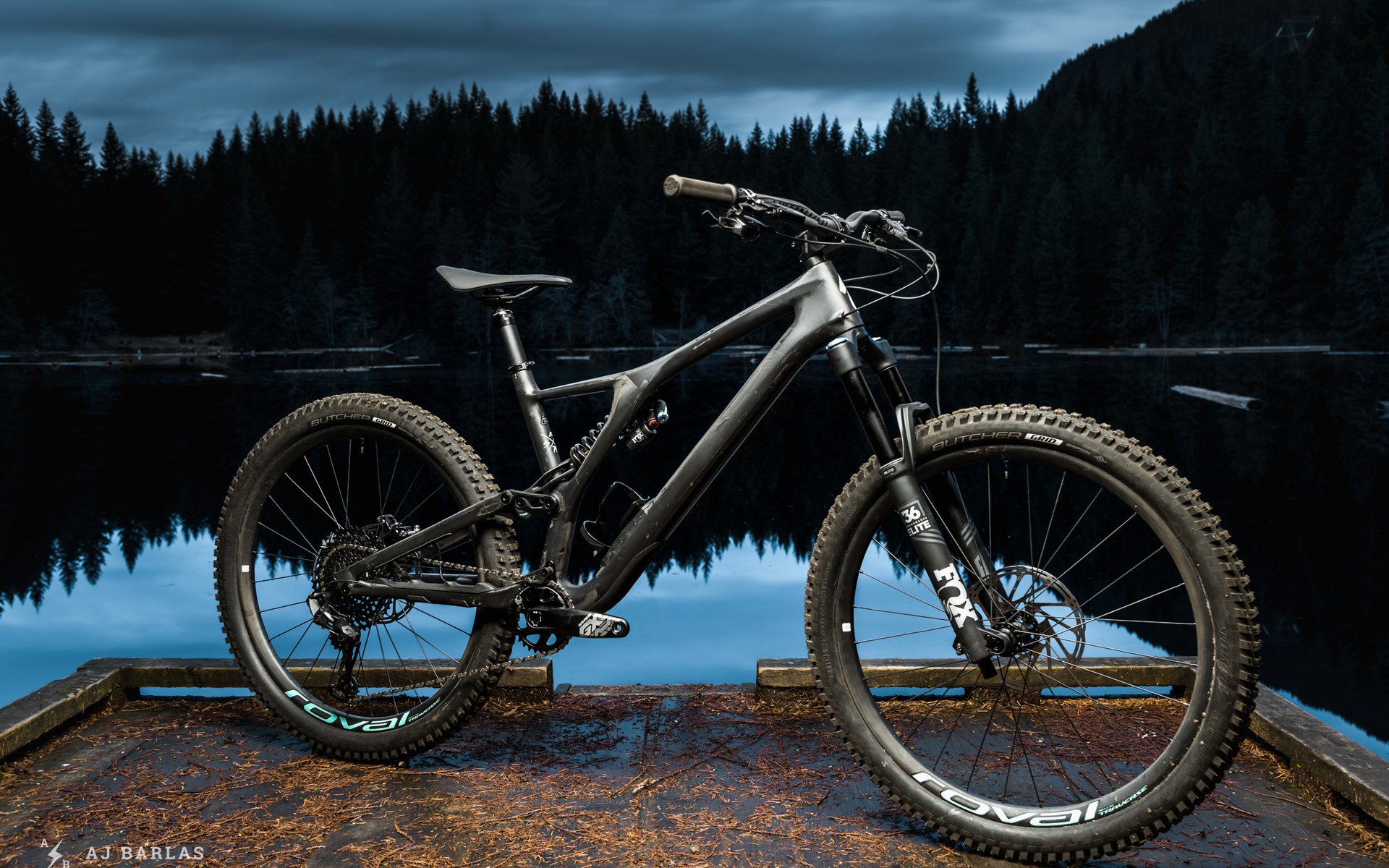
FIRST LOOK
Specialized Stumpjumper EVO Carbon
Anytime Specialized updates the Stumpjumper, it's news. This has been true since 1981, when the first Stumpy came on the scene. Like Porsche's 911, the Stumpjumper is a platform with many variations, against which many other manufacturers compare their own bikes. In 2018, Specialized released three different versions:
- Stumpjumper ST (short-travel): 120mm (29er) and 130mm (27.5) in alloy and carbon;
- Stumpjumper: 140mm (29er) and 150mm (27.5), in alloy and carbon, and
- Stumpjumper EVO: same travel as the Stumpjumper but with longer, slacker, lower geo - in alloy only
There are women's tunes as well, which feature the same geometry but lighter shock tunes and differences at the contact points. And as much as the line looked wide and deep, it was pretty clear that the Stumpjumper EVO was a bit of a toe dip; no carbon version, two sizes only (S2 and S3, rather than four sizes like the other models), and, since I only mentioned it one other time in this sentence - no carbon version. Not that it was disppointing. Quite the contrary. The lone spec version of the 2019 Stumpjumper EVO was notable because, in addition to the alloy frame, it boasted a sensible and affordable parts spec, and came in at 4,770 CAD / 3,600 USD. If Specialized's fingers were crossed about the reception it would get, they needn't have worried for long.
Still, we all wondered when the Stumpjumper EVO would be released in carbon. The answer is now.
Specialized Stumpjumper EVO Pro Carbon 27.5 / 29
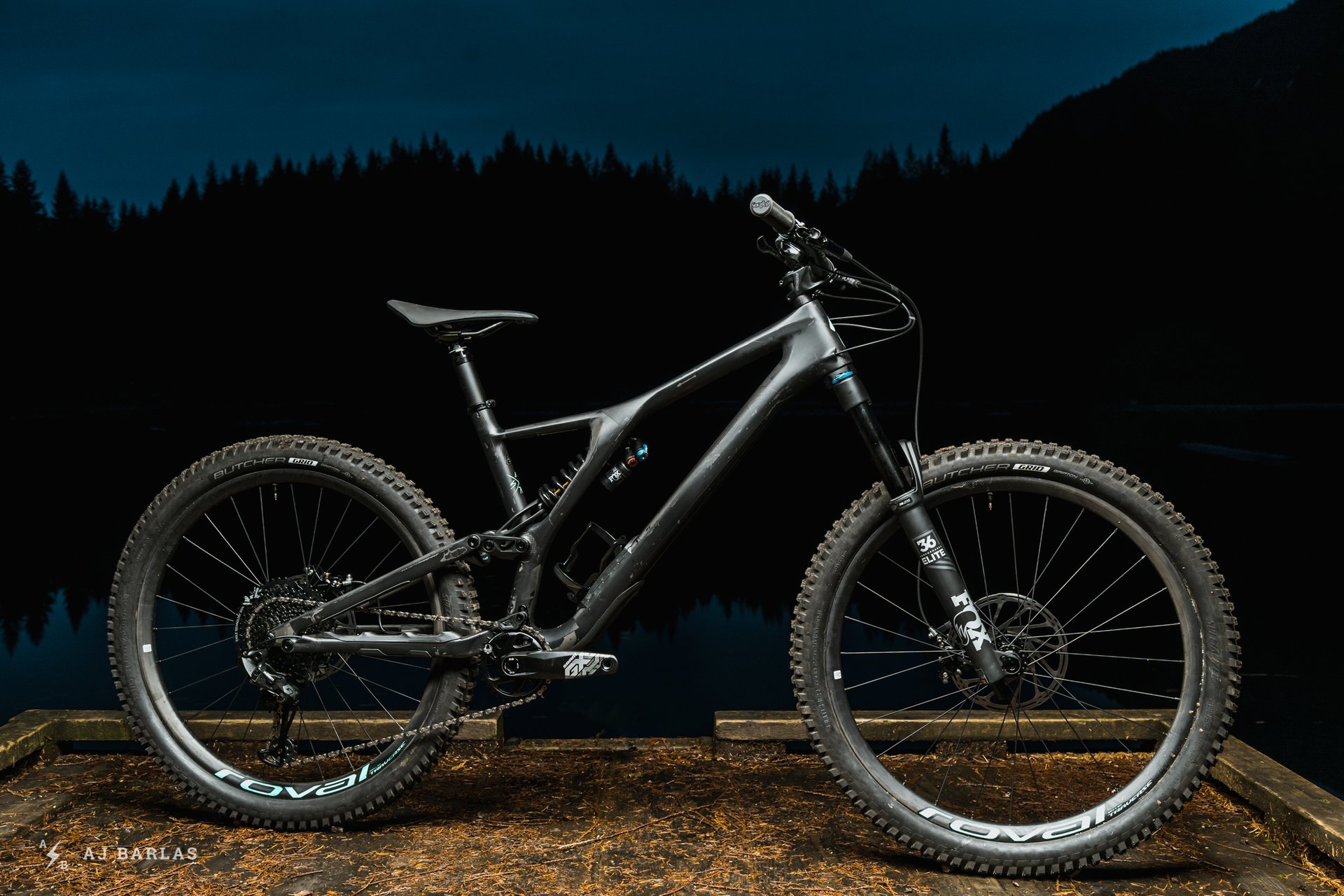
Let's start with two key similarities between the EVO Pro and the Comp. First, the new Carbon Stumpy EVO Pro comes in both 29 and 27.5 inch wheels, with corresponding travel measuring 140 and 150mm, respectively. Like the alloy version, there is only one trim level, unlike the alloy version, that trim level is the Pro - which is a step up from the Stumpjumper EVO Comp at every line item on the spec sheet.
The other notable similarity is that the carbon EVO shares the exact same geometry as the alloy version, a flip chip with high and low positions, and the same two size options: S2 and S3. So Specialized obviously felt that they nailed the numbers on the EVO the first time around for this generation. Here's a refresher on those numbers:
2018 Specialized Stumpjumper EVO Pro 29 Geometry
| Frame size: | S2 | S3 | ||
|---|---|---|---|---|
| Reach: | 445mm | 475mm | ||
| Top Tube (Horizontal): | 599mm | 635mm | ||
| Stack: | 619mm | 623mm | ||
| Seat Tube Length: | 400mm | 450mm | ||
| Head Angle: | 63.5º | |||
| Seat Tube Angle (Effective): | 76º | 75.6º | ||
| BB Drop: | 47mm | |||
| Chainstay Length: | 443mm | |||
| Front Center (mm): | 781mm | 813mm | ||
| Wheelbase: | 1,220mm | 1,252mm | ||
| Fork Offset: | 44mm | |||
| Trail: | 138mm | |||
2018 Specialized Stumpjumper EVO Pro 27.5 Geometry
| Frame size: | S2 | S3 | ||
|---|---|---|---|---|
| Reach: | 465mm | 490mm | ||
| Top Tube (Horizontal): | 615mm | 647mm | ||
| Stack: | 601mm | 610mm | ||
| Seat Tube Length: | 400mm | 450mm | ||
| Head Angle: | 63.5º | |||
| Seat Tube Angle (Effective): | 76º | 75.6º | ||
| BB Drop: | 33mm | |||
| Chainstay Length: | 440mm | |||
| Front Center (mm): | 790mm | 820mm | ||
| Wheelbase: | 1,228mm | 1,258mm | ||
| Fork Offset: | 37mm | |||
| Trail: | 137mm | |||
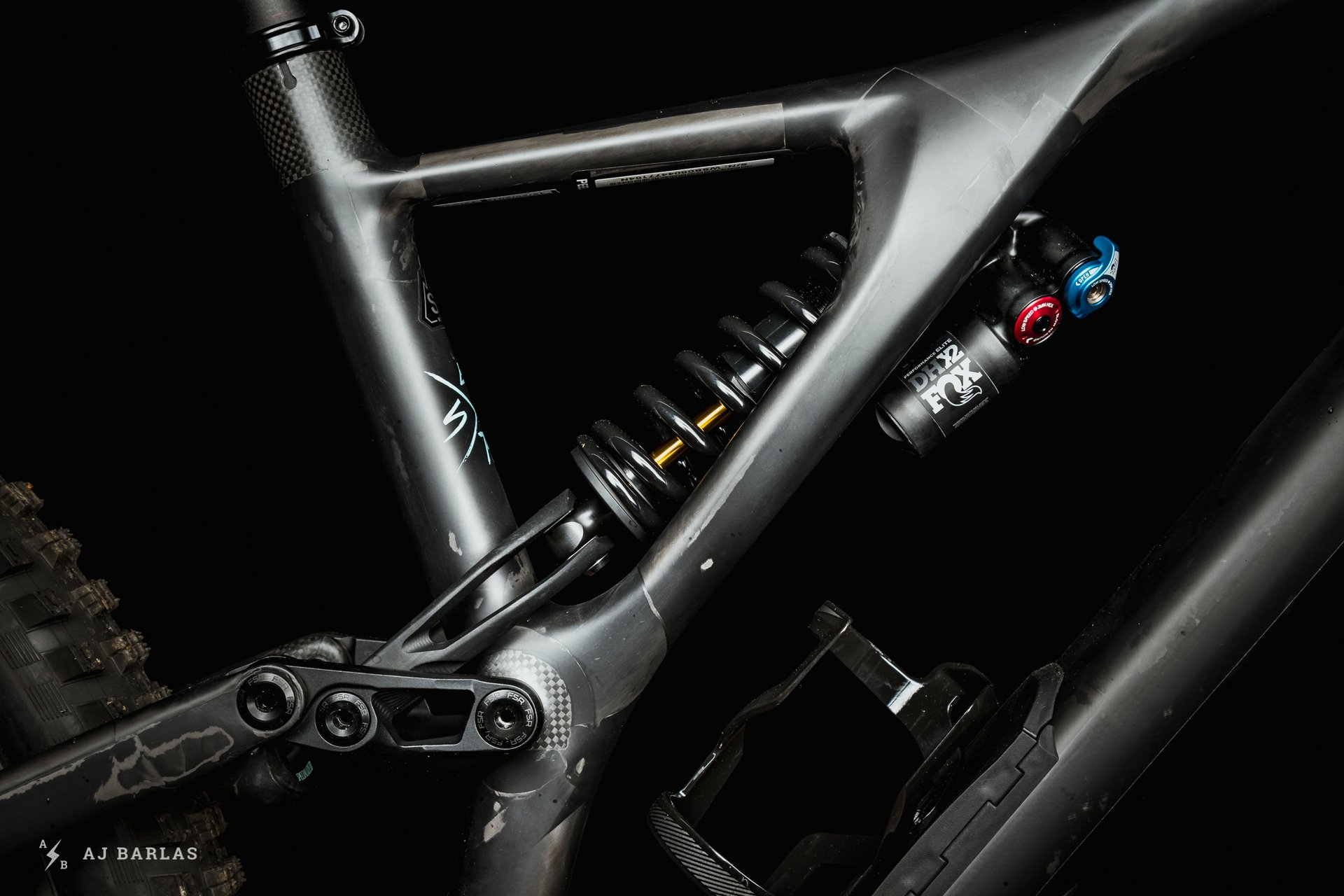
The Stumpjumper EVO Pro has a few notable differences from the EVO Comp - and you can see two of them in this photo.
So, we have identical geometry, two sizes available, and one trim level. After that, pretty much everything else is different between the Stumpumper EVO Comp and the new Pro version.
The EVO Pro has a full carbon frame, with the same asymmetrical design, a threaded BB, enclosed cable routing, and yes, that glorious SWAT door in the down tube, which was enlarged with last year's roll-out of this bike's cousins. The next thing you'll notice is that for the EVO Pro, Specialized decided to spec a coil shock - the Fox DHX2 Performance Elite, to be specific. Up front, suspension is handled by a Fox Float 36 Performance Elite at 150mm for both the 29 and 27.5 inch bikes. Both sensible, appropriate spec choices for this bike's intended use.
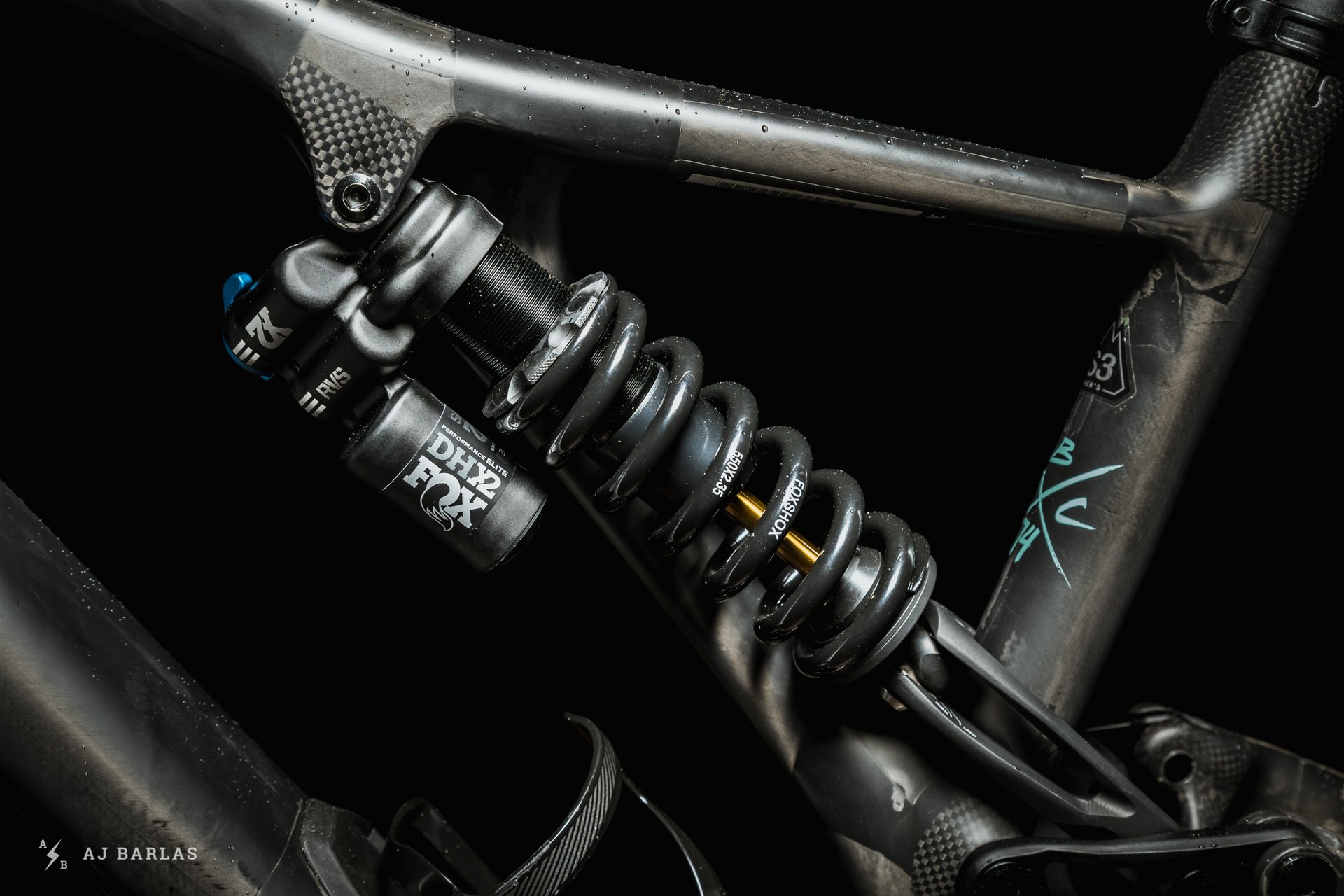
Specialized went with coil for the Stumpjumper EVO Pro, trusting squish to the Fox DHX2 Performance Elite.
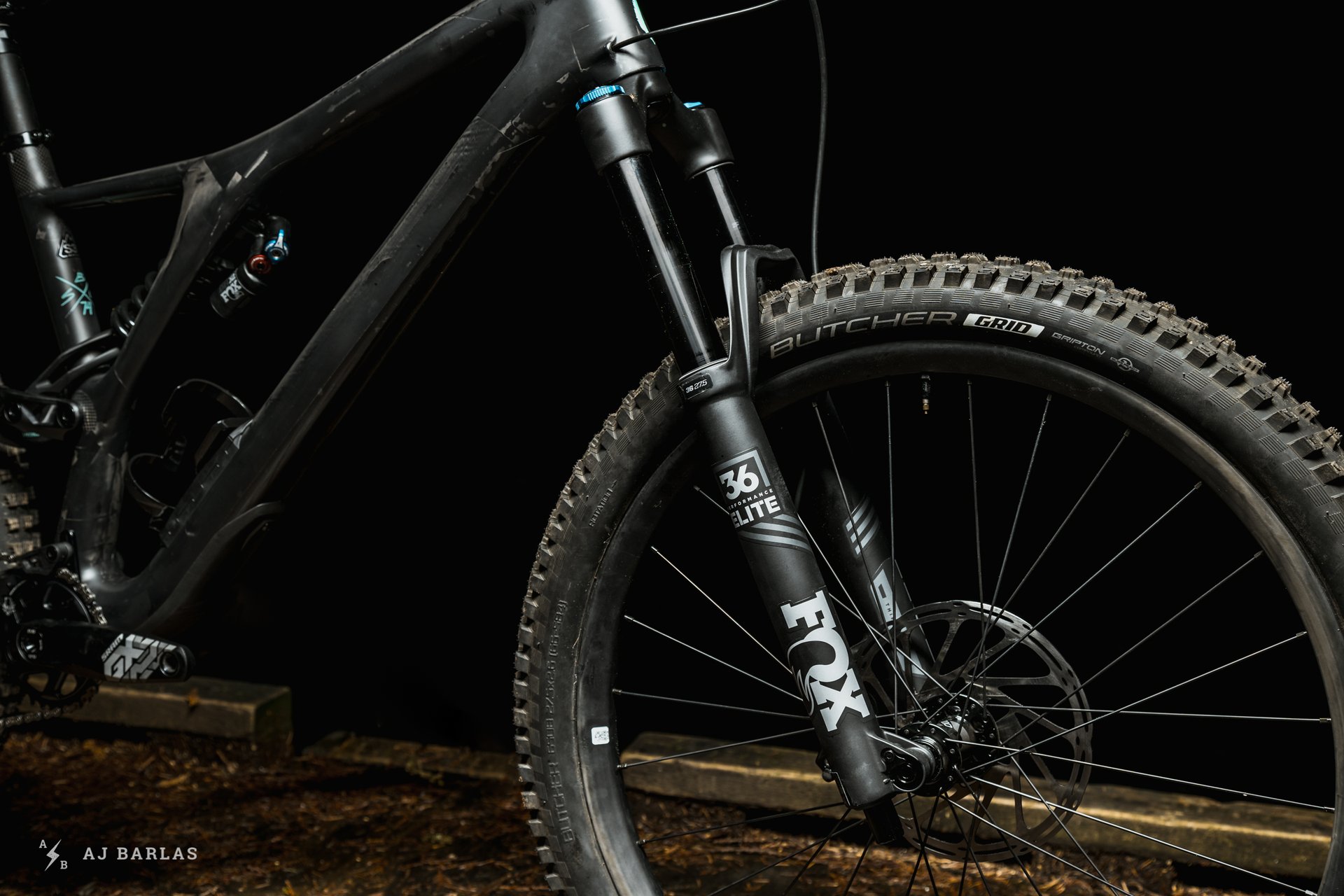
And up front, the 150mm Fox Float 36 Performance Elite. Nothing to complain about here.
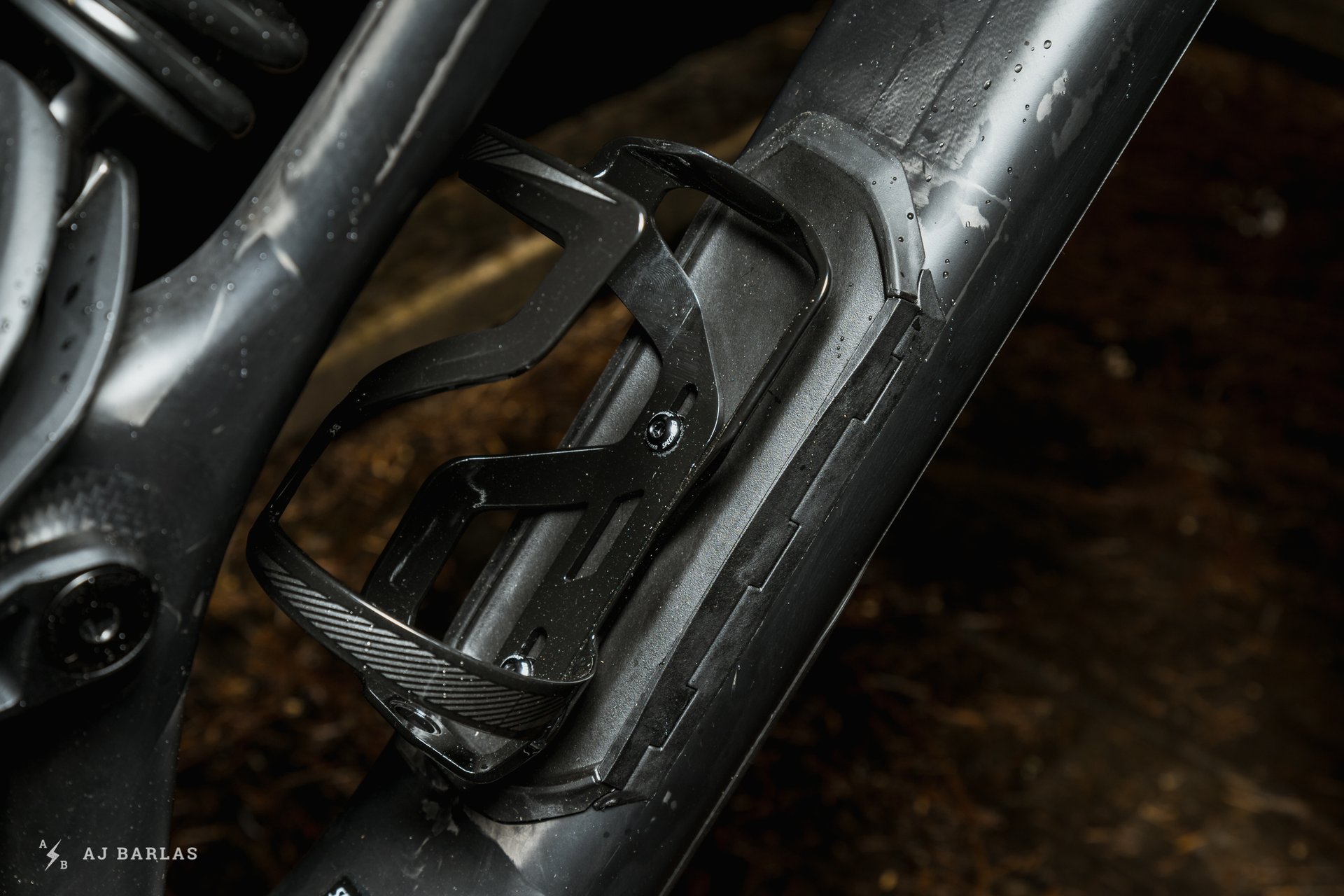
With Specialized carbon comes a SWAT compartment. If you've ridden or owned a Spesh that has one, you get used to having it in a hurry.
As you run through the rest of the spec, you only find more excellent, if unsurprising, choices. A complete SRAM GX Eagle group is the people's choice for reliable shifting and that sweet 10-50t cassette. It's amazing how quickly we've gotten used to 12 speeds and a 500% gear range from a single ring. Slightly more novel but no less excellent are SRAM Code RSC brakes with 200mm rotors front and rear.
More interestingly, Specialized spec'd Roval Traverse Carbon wheels, which have 30mm internal width rims, 28 spokes front and rear, and DT Swiss 350 hubs. Specialized Butcher tires at 2.6" front and rear give a stout patch of traction and bitey knobs. At 1200 USD / 1400 CAD, these are a budget-friendly carbon wheel. Still, as we'll see below, they were spec'd at the expense of going a little higher in cost with the suspension, which could make for a good debate over your next post-ride beer.
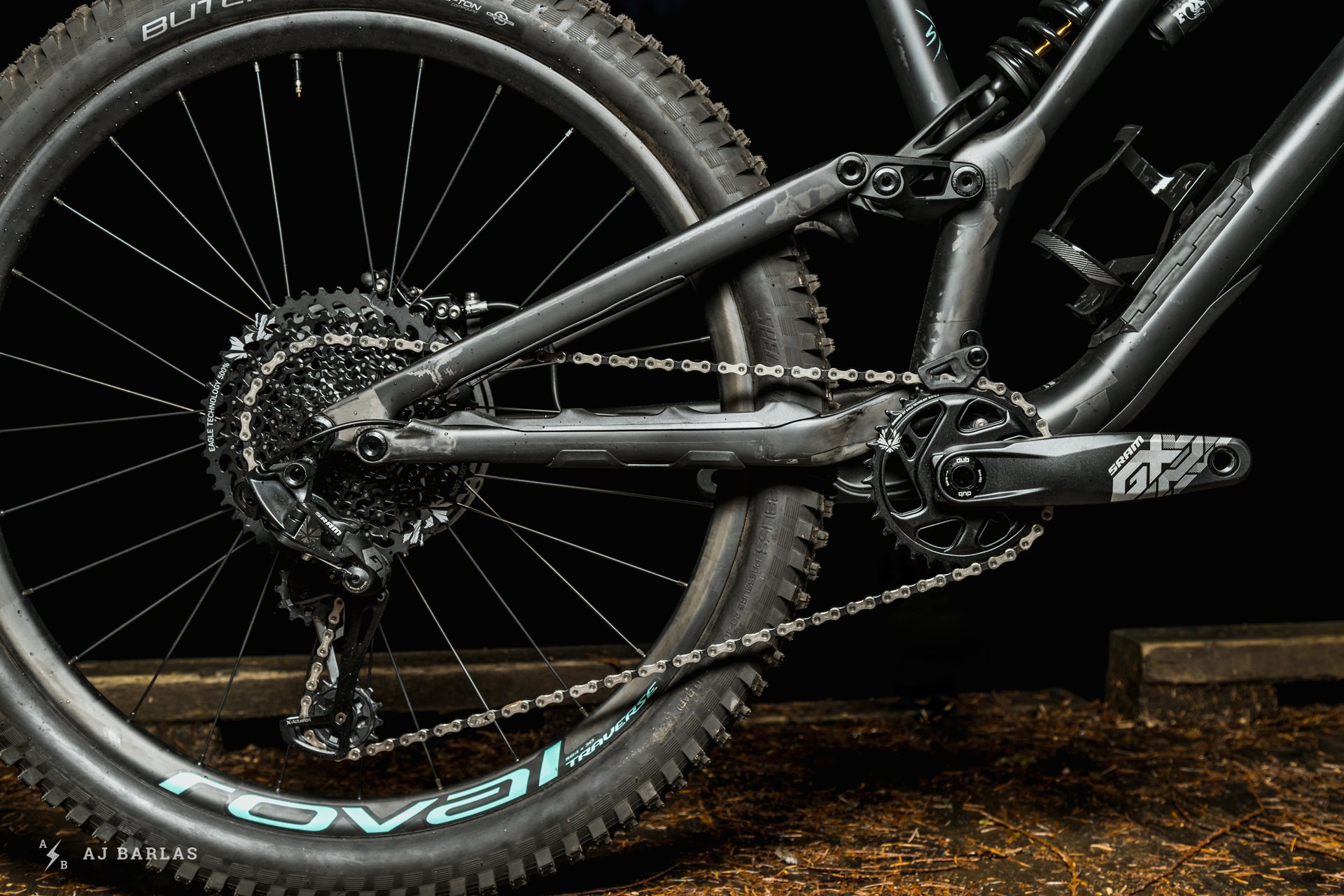
SRAM GX Eagle has become remarkable in its unremarkableness. A standard sight on so many bikes, it does its thing with little fanfare, at a reasonable cost.
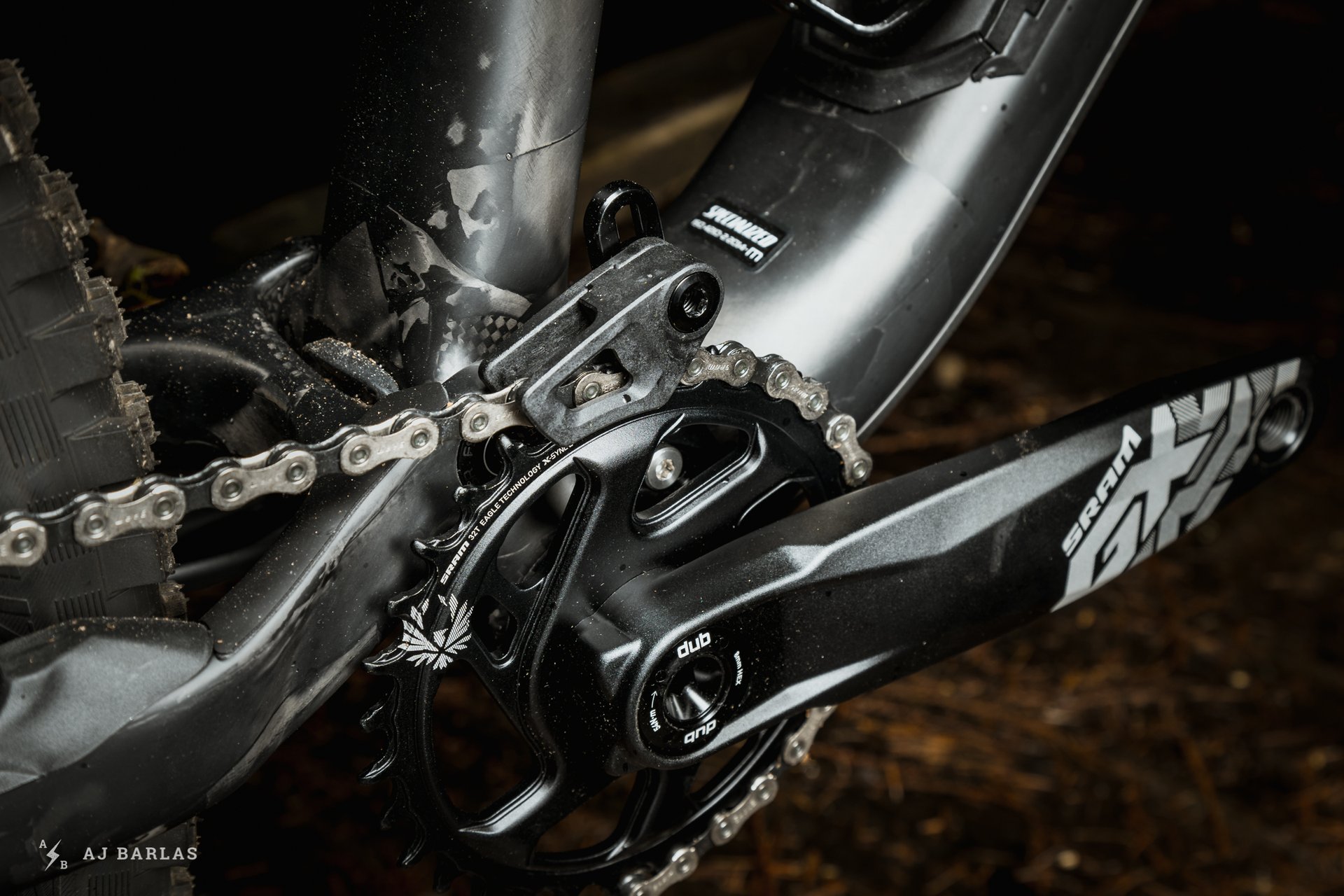
Included is Specialized's simple chainguide design. It can be flipped up without a tool but has remained secure in our time with it.
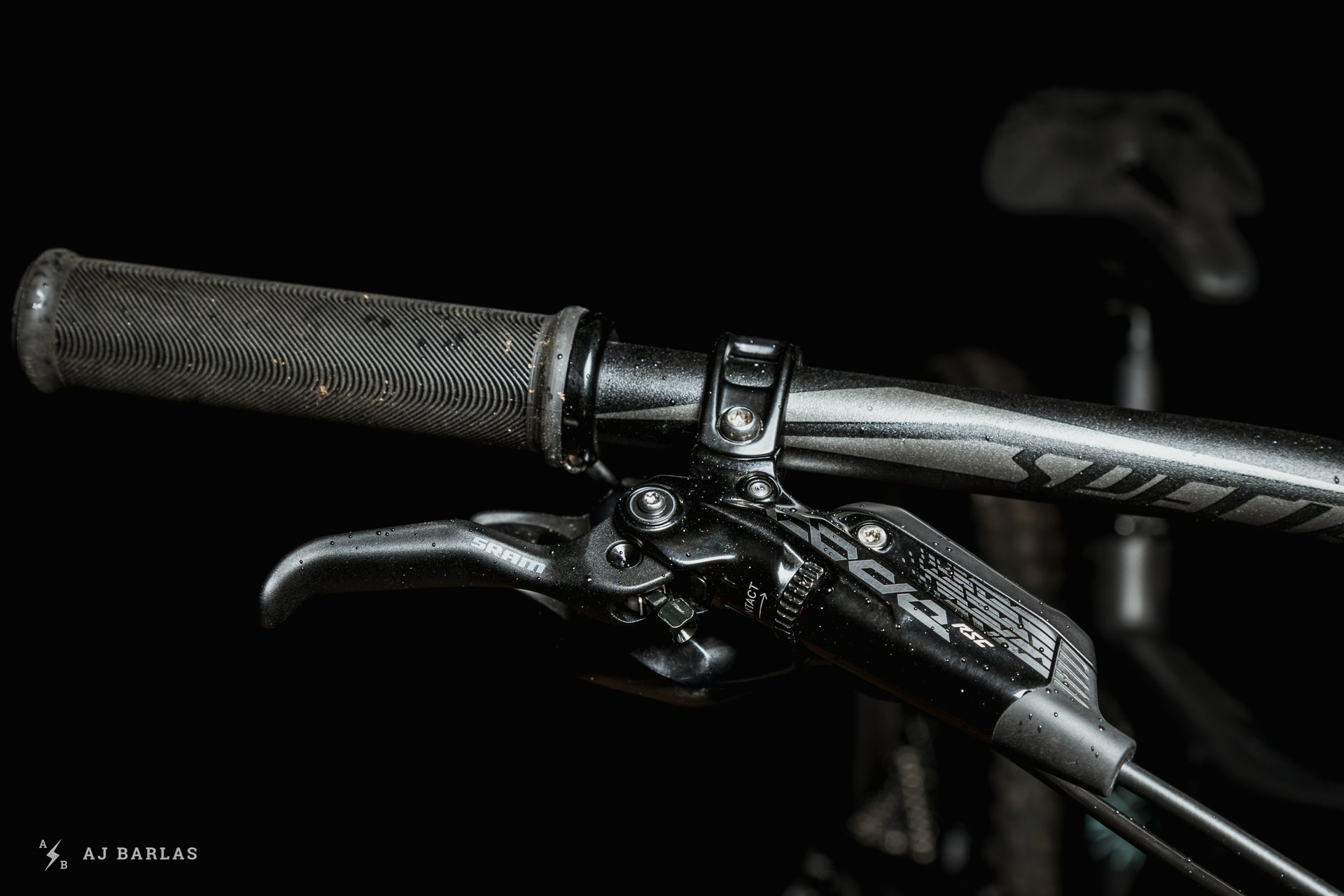
SRAM Code RSC brakes are a welcome sight on any bike that's going to need serious speed control on these trails.
Other notable bits: that SWAT multitool that pops up from under the stem cap, and chain stay protection that does such a good job keeping things quiet
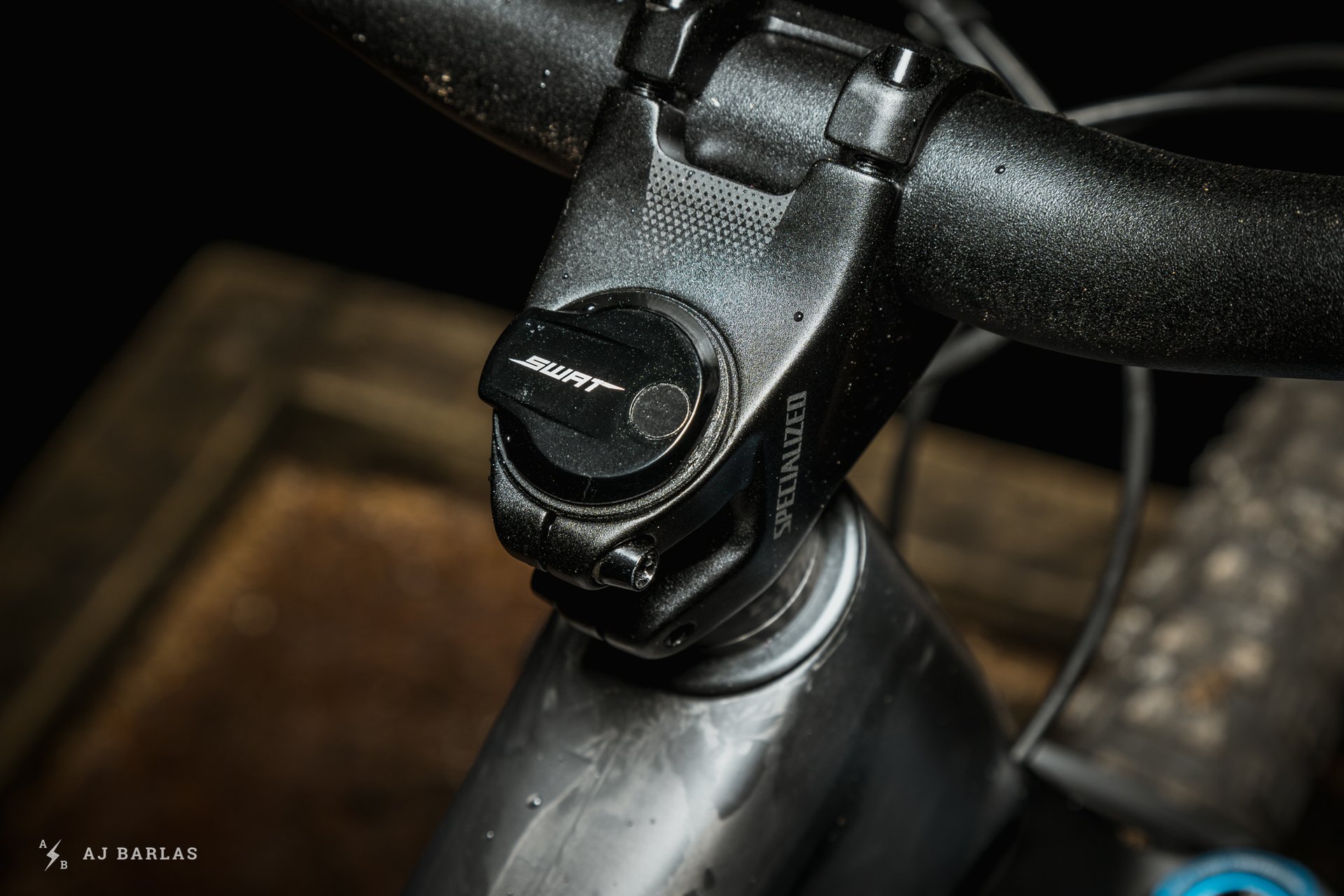
A quick flip...
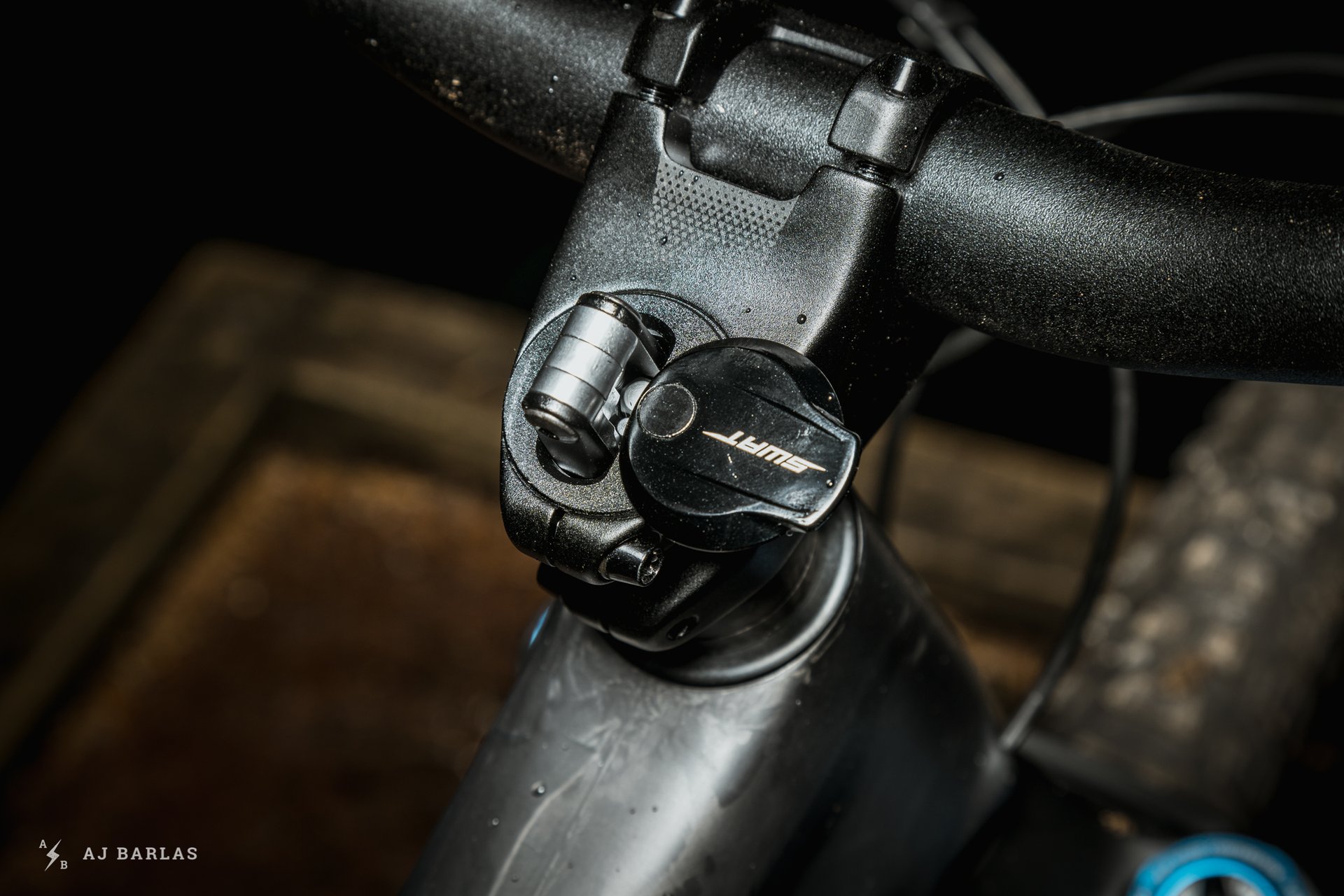
...reveals your easy access SWAT multi tool. So easy.
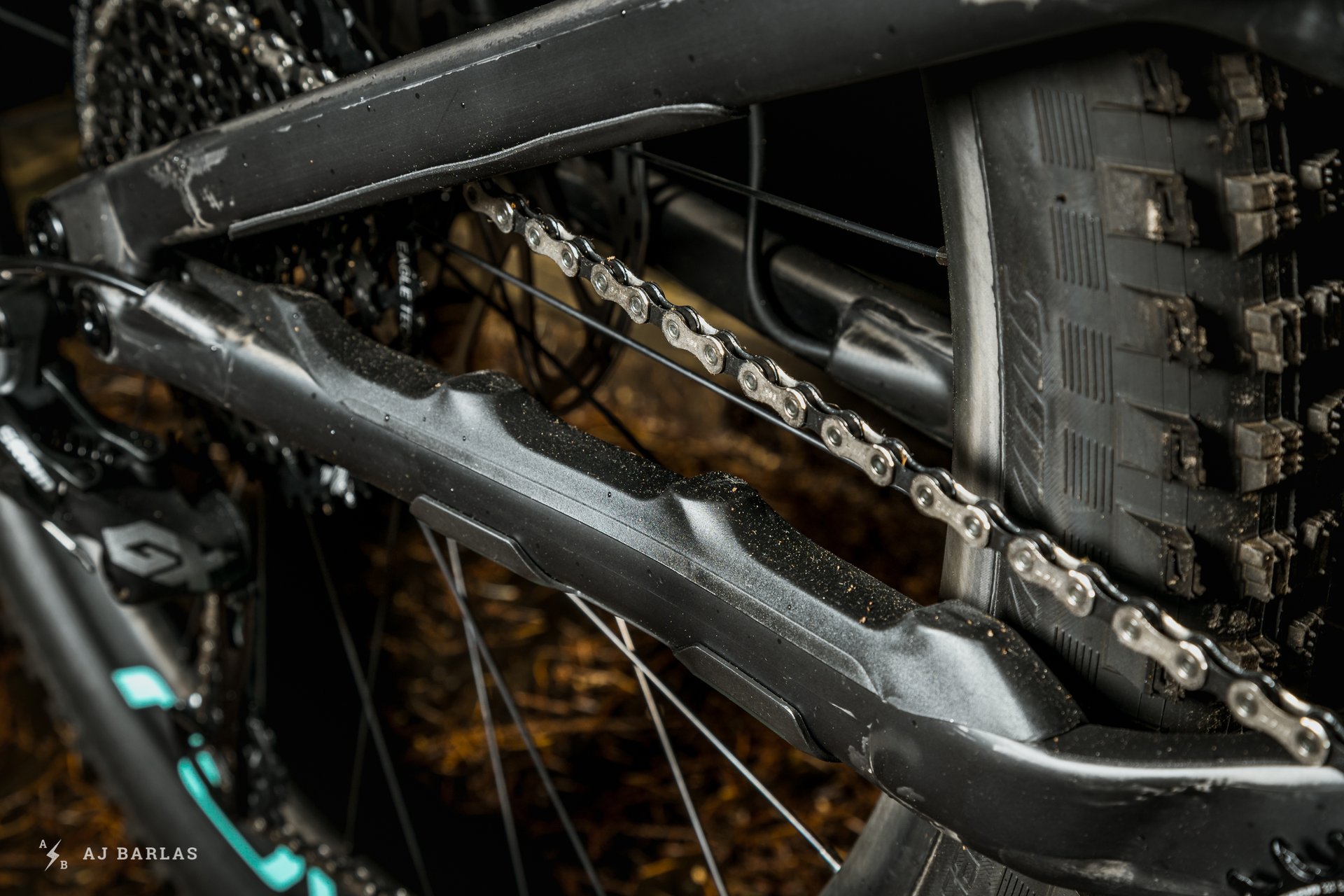
Stealth black waves keep that shiny thing quiet.
While I've had some rides on the Stumpy EVO Pro (we were sent the 150mm 27.5 inch version), the trail conditions in North Van have been very inconsistent over the last month, and riding in snow doesn't make for good testing. Early on I can say that the bike climbs very well and I enjoy the pedaling position and am looking forward to longer rides to get a better feel for it. The 490mm reach of the S3 size in Low position feels perfect for me at 6' 1 with a long torso. I'll reserve getting into its descending characteristics just yet, and save that for the full review, but one thing I'm curious to see is how I get along with the low BB - the 33mm BB drop certainly means I'll be giving both High and Low positions a go. Our technical climbing will no doubt have my thinking about running the High position.
The other thing that interests me is the question of intended buyer for this bike. There's a lot of crossover with the Enduro, albeit at a difference in travel and geo - interesting that in this case the shorter travel bike has the more aggressive geometry, including a longer wheelbase. Perhaps the next edition of the Enduro will correct that, but for now, it should be fun getting to know this Stumpy EVO as Spring rolls up on us.
For the myriad changes over the spec of the Stumpjumper EVO Comp (carbon frame, carbon wheels, all the higher end spec) you end up with an MSRP that is double. Whereas the Stumpjumper EVO Comp retails for $4,769 CAD, the EVO Pro comes with a sticker price of $9,291 CAD. If that's outside your budget, fear not: a Comp carbon version (with the alloy version's parts build) and frame only Stumpjumper EVOs in carbon and alloy are on the way.
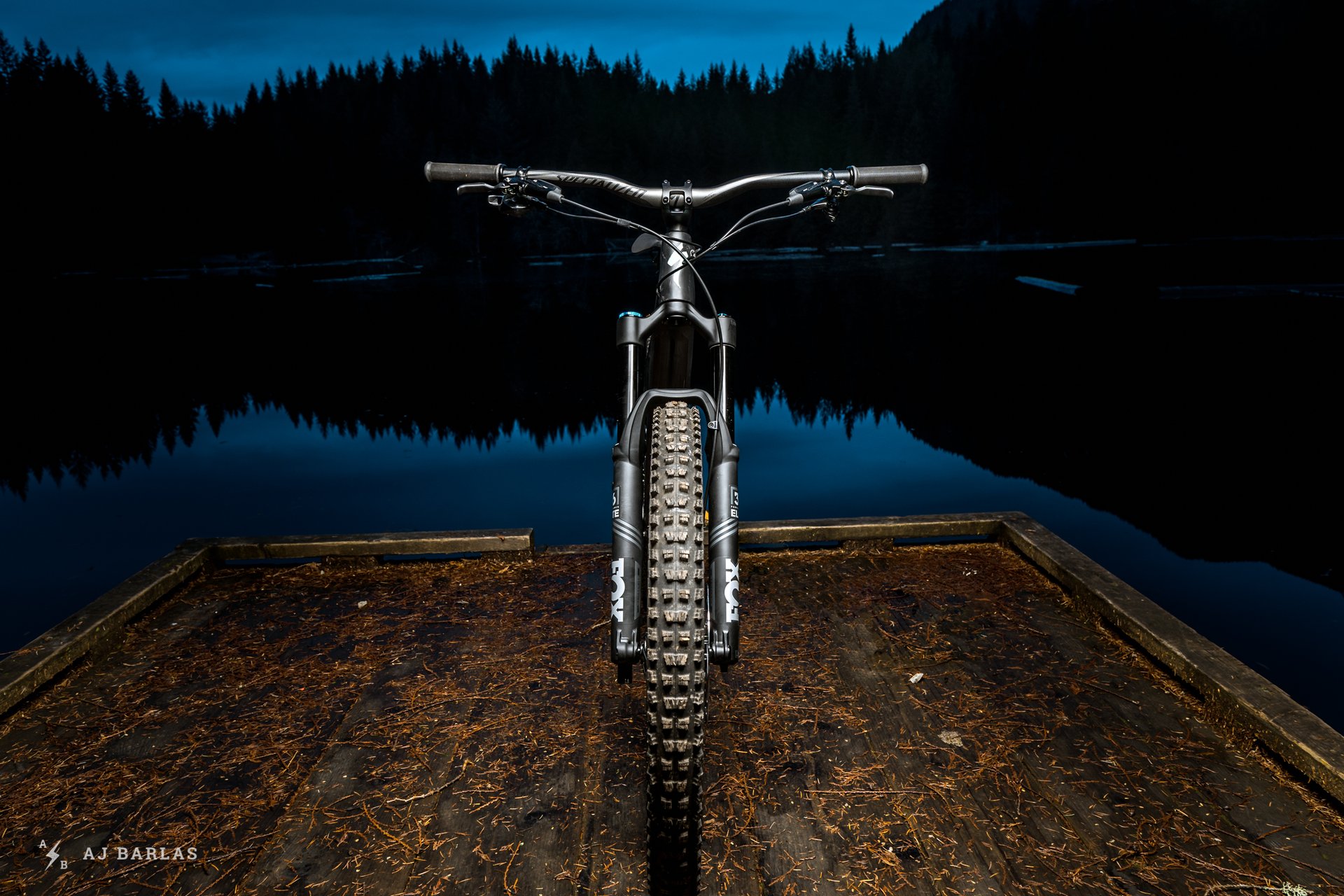
Black. Planted. Ready.
We had a few questions about the new bike, so AJ ran them by Specialized PR rep Sean Estes...
The 2018 Stumpy EVO was built around an alloy frame. What’s changed with the move to carbon?
The geo is identical, but we bring in the SWAT downtube storage and drop about 800g compared to the alloy frame. There is also a new clevis style seat stay that brings in a bit more stiffness to the frame compared to the standard models (about 7%).
The 2018 alloy model was shipped with uncut steerer tubes giving riders more flexibility with sizing. This carbon one was cut and set. What happened to the uncut steerer?
We wanted to simplify things for our dealers getting these bikes on the shop floor, so we now ship with cut steerers and 30mm of spacers installed. Still allows for the flexibility of sizing and limits the amount of forks that are prematurely cut short when they are being assembled by a dealer.
EVO carbon comes with a coil shock. What pushed Specialized in that direction?
We think coil shocks are fun and fit with the character of the EVO. The supple feel off the top and consistency on longer descents is great, plus we landed on a tune that also allows for a nice pedal platform for climbing.
The spec. is reasonable but I can’t help but note the carbon wheels and lower (though still adequate) suspension spec. Why not spec alloy wheels and a higher end suspension setup?
There’s always a ton of fun internal debates here on how we spec the bikes. Ultimately, Performance Elite level suspension and carbon rims felt like a more compelling bike for riders than alloy rims and Factory level Fox suspension. We like carbon rims -they make a noticeable difference on the trail in rider quality over alloy rims. Kashima looks amazing, but for this particular spec, we really wanted to prioritize ride quality.
Where’s the S4? :)
EVO for Specialized has always been about pushing a bit further than normal on the geometry and spec of the bikes- so far the response to this version has been really positive. Based on this we are looking at ways to bring this style of geometry to a broader range of riders. How and when is still being worked on, but it is something we are all very excited about doing.
Are you able to share the leverage curve, anti-squat and anti-rise details with me? If you’re able to provide charts that would be so good! How do they differ from the regular Stumpy would be amazing too.
Hardpoints for the EVO are very similar to the standard bike as a result leverage rate, anti-rise, and anti-squat are all super close (within 2%). We do make some changes in shock tune- for the Carbon EVO we bring in a bit more compression damping because of the coil spec and on the alloy bike we do some different things with the air spring from the standard bike to bring in a bit more progressivity and bottom out resistance.







Comments
Shinook
5 years, 1 month ago
I don't think those geometry figures are correct for the EVO models, the EVO has a 64 HTA, 44 rake, and 76 STA (depending on flip chip settings).
Reply
dtimms
5 years, 1 month ago
Those numbers look like the Stumpjumper ST. 67.5 HA doesn't seem correct.
Reply
Pete Roggeman
5 years, 1 month ago
Thanks for that - bad copy and paste last night. Numbers are fixed now.
Reply
nick bitar
5 years, 1 month ago
Having a ball on the S3 650b Evo in lowly alloy. The sizing is awesome and the bike has seamlessly transitioned from double black DH to local blue XC trails much better than I thought it would.
The short seat tube is cool, but a bit pointless when the insertion depth is so shallow. My legs are on the short side for a 183cm fellow and the stock 150mm post is about all I can manage, even with 100mm or more post showing.
And why the shorter reach on the 29’er?!? I would have loved a 29’er with the longer cockpit or the 60b!
and there are all all my complaints.... it’s a short list! This isn’t an Enduro. The geo is very progressive but the back end is more efficient than plush. People looking for an Enduro racer have had a lot of luck long shocking it for a plush ride, but I’m pretty happy with the awesome climbing + perkiness on such a big bike.
The stock alloy build is great for a bike bought from a dealer. Spending more money really only shaves weight. Performance is brilliant out of the box!
Reply
TallNeil
5 years, 1 month ago
The real question is how do they take such awesome photos of the bike standing up in the air?
Reply
Niels van Kampenhout
5 years, 1 month ago
Cool bike. I think the alloy one looks better though!
Pete, when you say "lower suspension spec", is that just because it has no kashima coating? I don't think there is any other difference between Performance Elite and Factory.
Reply
AJ Barlas
5 years, 1 month ago
The coil here also doesn’t include four-way adjustability like it’s kashima clad sibling.
Reply
Niels van Kampenhout
5 years, 1 month ago
Ah, missed that, thanks!
Reply
JVP
5 years, 1 month ago
Coil with the same leverage curve as air. Oh snap!
Reply
Vik Banerjee
5 years, 1 month ago
On PB they had to bump up the spring rate quite high to avoid bottoming out. So it doesn't sound all that sorted for a coil.
Reply
Nouseforaname
5 years, 1 month ago
But coil shocks are so HOT right now! Can you just imagine the engineer who has spent two years (or more) designing this to work with an air shock, being told 3 months before launch "oh BTW we'e shipping it with a coil shock, that's OK - right? It's what those guys over at Pinkbike said everyone wants now".
Reply
JVP
5 years, 1 month ago
> JVP says: Coil with the same leverage curve as air. Oh snap!
Whoah, accidentally removed my comment when trying to reply. Oh double snap!
Reply
Niels van Kampenhout
5 years, 1 month ago
I retrieved your removed comment from the bin ;-)
Reply
Andrew Major
5 years, 1 month ago
Really no different than the awesome bikes out there designed around a 51mm offset where companies decided it was easier to make them less-awesome but on point with fork offset trends than to try and educate customers on why good geo (including fork offset) is a package.
Reply
Timer
5 years, 1 month ago
There is this weird trend of bike brands speccing coil shocks on their top spec bikes, even though the frames are designed for air shocks.
Same with the Orbea Rallon and Mondraker Foxy.
Reply
UFO
5 years, 1 month ago
I thought I had read the bump up was from stock 550lb to 600lb, and it was more due to the bike 'feeling' it was too deep into sag vs constantly bottoming out
Reply
DangerousDave
5 years, 1 month ago
I asked this over on PB, but I'll ask here as well because I'm genuinely curious. How many people riding a 400mm seat tube (let's call this a small, medium if we're being generous) need a 470mm reach? That's the equivalent to many XXLs in 2016 or XLs in 2017/18. Do people just straight line through the trails? This geo trend doesn't make any sense to me.
Reply
JVP
5 years, 1 month ago
Droppers.
Reply
AJ Barlas
5 years, 1 month ago
And they're getting longer. Having more space makes room to get the seat even more out of the way.
Reply
Metacomet
5 years, 1 month ago
I do Love short seat tubes, but it's a funny thing on a bike like the stumpy where the seat tube is interrupted so high up and effectively remains consistent through all sizes due to pivot placement/bent seat tube. This makes the available insertion depth on those small sizes incredibly shallow. Always leaves you with a lot of exposed seat post above the clamp and really impedes droppers for shorter people/smaller sizes. But I agree, most especially on a bike like this it is better to have the seat tube be shorter so the lower saddle height is at least available with a dedicated rigid post for someone that may use this primarily in the bike park. But this thing just doesn't have the insertion depth for a 175-200mm dropper unless you have incredibly long legs, which is a shame given its intended use.
Reply
Cr4w
5 years, 1 month ago
The longer reach is mandated by the steeper seat angle. That steeper angle puts the rider way forward and that consumes a lot of reach. With the rider further forward less of the cockpit is behind the BB. It's a shift of distance from the effective top tube to reach.
You can't really compare a 2018 bike's reach with one from 2015 with a 73' seat angle. Go ride one and see for yourself.
I had a bike that was 490/74 and it was fine. Then I tried a bike that was 500/76 and it was too small - like, knees hitting the bar too small. Then I went to 535/77 and life is good again.
I agree that some of these seat tube lengths are getting a bit crazy short, but that's just my long inseam talking.
Reply
DangerousDave
5 years, 1 month ago
But the seated length (butt-to-hands) has remained about the same since seat tube angles have increased along with reach. For example most medium frames still have an ETT of between 600-615mm as they did 3-4 years ago. But the standing length (ie. reach or feet-to-hands) is now 2-3 sizes bigger. So standing/descending on a medium 2019 Stumpy Evo is like standing/descending on a XXL bike from 2016 from a fit perspective. So if we could go back to 2016 (only talking about standing/descending position) we would tell people that they actually needed to size up 3 sizes.
Reply
hongeorge
5 years, 1 month ago
510 reach here, on a (I think) 450 ST. It's less weird than you'd think. I expected to be all sorts of weirded out when I finished building the bike and finally sat on it, and it wasn'tstrange at all, felt right
Reply
ChazzMichaelMichaels
5 years, 1 month ago
The cable routing is a bit shitty for right hand front brake. How hard would it have been to have two holes on either side for a total of four instead of three? It means that either the rear brake or LH dropper cable is doing a sharper turn into the frame.
Reply
Please log in to leave a comment.